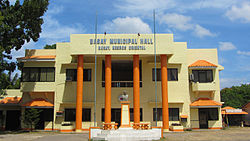Basay | |
|---|---|
| Municipality of Basay | |
 Municipal Hall | |
 Map of Negros Oriental with Basay highlighted | |
 Interactive map of Basay | |
Location within the Philippines | |
| Coordinates: 9°25′N122°38′E / 9.42°N 122.63°E | |
| Country | Philippines |
| Region | Negros Island Region |
| Province | Negros Oriental |
| District | 3rd district |
| Founded | June 15, 1968 |
| Named after | Visayan term "busay", meaning "spring" |
| Barangays | 10 (see Barangays) |
| Government | |
| • Type | Sangguniang Bayan |
| • Mayor | Jonny A. Wagas (Lakas) |
| • Vice Mayor | Nelie M. Gabas (Ind) |
| • Representative | Janice Degamo (Lakas) |
| • Municipal Council | Members |
| • Electorate | 22,235 voters (2025) |
| Area | |
• Total | 162.00 km2 (62.55 sq mi) |
| Elevation | 74 m (243 ft) |
| Highest elevation | 686 m (2,251 ft) |
| Lowest elevation | 0 m (0 ft) |
| Population (2024 census) [3] | |
• Total | 30,018 |
| • Density | 185.30/km2 (479.92/sq mi) |
| • Households | 6,984 |
| Economy | |
| • Income class | 4th municipal income class |
| • Poverty incidence | 40.12 |
| • Revenue | ₱ 201.5 million (2022) |
| • Assets | ₱ 439 million (2022) |
| • Expenditure | ₱ 152.4 million (2022) |
| • Liabilities | ₱ 131.1 million (2022) |
| Service provider | |
| • Electricity | Negros Oriental 2 Electric Cooperative (NORECO 2) |
| Time zone | UTC+8 (PST) |
| ZIP code | 6222 |
| PSGC | |
| IDD : area code | +63 (0)35 |
| Native languages | Cebuano Tagalog Hiligaynon |
Basay, officially the Municipality of Basay, is a municipality in the province of Negros Oriental, Philippines. According to the 2024 census, it has a population of 30,018 people. [5]



